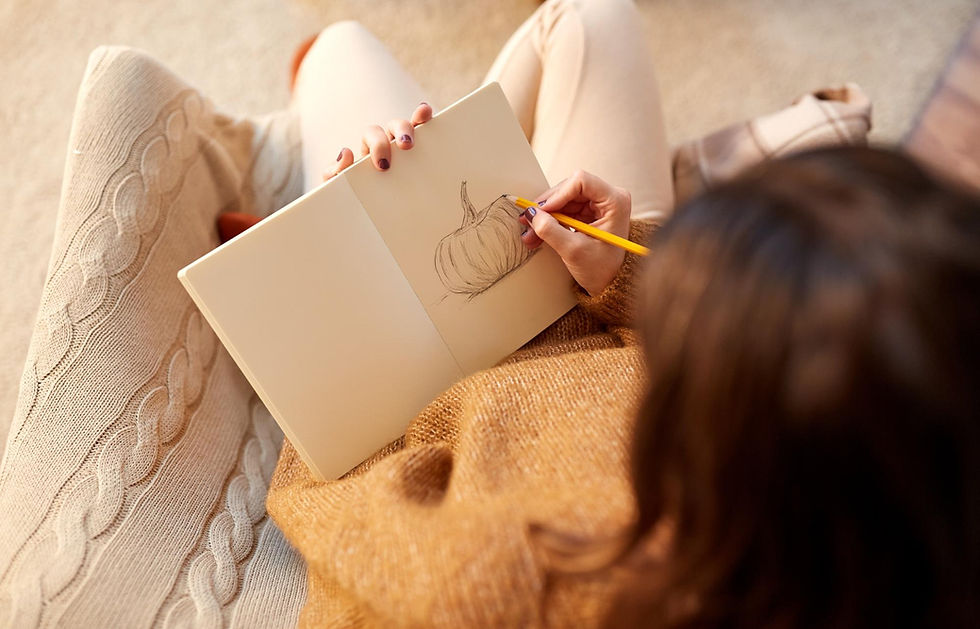Drawing Your Way to Calm: The Meditative Magic of Art🌿
- jmshortt
- Nov 22, 2024
- 4 min read

Hello, dear friends!
Let’s talk about something simple, creative, and deeply soothing: drawing. Whether you’re sketching doodles on a napkin or layering intricate patterns in a journal, drawing has an almost magical ability to quiet the mind and slow down the chaos of everyday life.
You don’t need to be the next Picasso to enjoy the benefits. In fact, some of the most meditative moments come from picking up a pencil and letting your hand flow freely. Let’s explore why drawing is such a wonderful tool for meditation and how it can help you find calm amidst the busyness of life.
Why Drawing Works as Meditation
Meditation isn’t just about sitting cross-legged and focusing on your breath (though that’s lovely too). It’s about being present in the moment—and drawing has a unique way of pulling you into that state. Here’s why:
It Grounds You in the Present
When you’re drawing, you naturally focus on the movement of your hand, the texture of the paper, and the shapes forming before your eyes. This gentle attention pulls you into the now—a much-needed escape from the “what-ifs” and “should-haves” running laps in your mind.
It Slows Your Brain Waves
The rhythmic motion of sketching or coloring can shift your brain into a calmer state, similar to what happens during meditation. Your brain waves slow down, helping you feel relaxed and centered.
It’s a Safe Space for Expression
Sometimes, words aren’t enough to express what’s going on inside. Drawing offers a nonverbal outlet for emotions, allowing you to process and release stress, anxiety, or even joy in a way that feels natural.
It Encourages Flow State
Have you ever been so absorbed in something that time seems to melt away? That’s called “flow,” and drawing is a fantastic way to get there. In this state, your worries fade, and you’re completely immersed in the creative process.
The Benefits of Drawing for Meditation
1. Reduces Stress and Anxiety
The repetitive motion of drawing can be as calming as a mantra. It soothes the nervous system, helping to reduce cortisol levels and ease anxiety.
2. Boosts Focus and Clarity
By focusing on the lines, shapes, and patterns, you give your mind a break from multitasking. This single-pointed focus can help you think more clearly and feel more centered.
3. Enhances Self-Awareness
As you draw, you may notice how your body feels, the pace of your breathing, or the emotions that arise. This heightened self-awareness is a cornerstone of mindfulness.
4. Sparks Creativity
When your mind is quiet, creativity has room to flourish. Drawing as a meditative practice isn’t about making something perfect; it’s about letting your imagination wander and creating from a place of curiosity and joy.
5. Promotes Emotional Healing
Art therapy is a well-known tool for emotional healing, and drawing is no exception. It gives you space to process emotions, reduce mental clutter, and reconnect with yourself on a deeper level.
Easy Ways to Get Started with Meditative Drawing
You don’t need fancy tools or prior experience to start reaping the benefits. Here are a few beginner-friendly ideas:
1. Doodle Freely
Grab a pen and paper and let your hand wander. Draw loops, squiggles, or geometric shapes. There’s no wrong way to doodle!
2. Try Zentangle
This structured form of drawing involves repetitive patterns, which is incredibly calming. Start with a small square and fill it with intricate designs—like lines, circles, or swirls.
3. Draw from Nature
Step outside, find a leaf, flower, or cloud that catches your eye, and sketch it. Focusing on the tiny details of nature is both grounding and inspiring.
4. Mandalas
Drawing or coloring mandalas—circular patterns with symmetrical designs—is a deeply meditative practice. You can create your own or use pre-drawn templates.
5. Keep a Visual Journal
Combine sketching with journaling by creating a visual diary. It doesn’t need to be fancy; even simple drawings that reflect your mood or experiences can be powerful.
Make Drawing Part of Your Routine
The beauty of meditative drawing is that it’s flexible. You can carve out five minutes during your morning coffee or dedicate an hour on a Sunday afternoon. Here are some tips to help you make it a regular habit:
Set Up a Creative Space: Find a cozy corner where you can leave your sketchpad and supplies.
Start Small: Even 5-10 minutes can make a big difference.
Let Go of Perfection: This isn’t about creating “good” art—it’s about the process.
Pair It with Music or Silence: Some people find that soft music enhances their focus, while others prefer quiet. Experiment to see what works for you.
Make It Sacred: Light a candle, brew a cup of tea, or set an intention before you begin.
A Gentle Reminder
You don’t have to be an artist to benefit from meditative drawing. This is about the experience, not the outcome. Each line, dot, or swirl you create is a step toward mindfulness and self-discovery.
So, grab a pen, a notebook, or even a crayon, and let your mind slow down as your hand creates. You might be surprised at how much peace you can find in a single stroke of a pencil.
Are you ready to draw your way to calm? I’d love to hear about your experiences or see your creations—share them in the comments!
You can also check out the journals available in our collection to get you started! 🌻




コメント